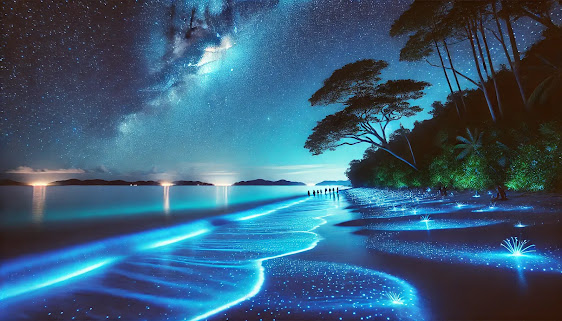The World’s Best Bioluminescent Beaches
Imagine walking along a beach at night as the waves sparkle with glowing blue lights, resembling a starry sky beneath your feet. Bioluminescent beaches are some of nature’s most magical phenomena, caused by microorganisms like plankton emitting light in response to movement. These destinations are perfect for adventurers and nature lovers seeking unforgettable experiences.
This guide explores the world’s best bioluminescent beaches, offering tips on when and where to witness this breathtaking natural wonder.
What Causes Bioluminescence?
Bioluminescence occurs when living organisms emit light through chemical reactions. On beaches, the glow often comes from dinoflagellates, a type of plankton, or sometimes bioluminescent algae. When disturbed by waves or footsteps, these organisms light up, creating a surreal and magical effect.
Top Bioluminescent Beaches Around the World
1. Vaadhoo Island – Maldives
Vaadhoo Island in the Maldives is famous for its “Sea of Stars,” where the ocean glows with a mesmerizing blue light. The tranquil setting and crystal-clear waters make it one of the best places to experience bioluminescence.
Best Time to Visit: Year-round, but especially during late summer.
What to Expect: A romantic and serene experience perfect for honeymooners or couples.
Tips: Stay at a beachfront resort for easy access and enjoy stargazing alongside the glowing waves.
2. Mosquito Bay – Vieques, Puerto Rico
Often referred to as the brightest bioluminescent bay in the world, Mosquito Bay is a must-visit. Located on the island of Vieques, the bay glows brilliantly due to its high concentration of dinoflagellates.
Best Time to Visit: Moonless nights for optimal visibility.
What to Expect: Guided kayak tours that let you paddle through the glowing water.
Tips: Avoid wearing sunscreen or insect repellent, as these can harm the delicate ecosystem.
3. Halong Bay – Vietnam
Halong Bay is not only famous for its towering limestone karsts but also for its glowing waters. At night, the bay occasionally sparkles with bioluminescent plankton, creating an otherworldly effect.
Best Time to Visit: Summer months when plankton activity is highest.
What to Expect: A mix of natural beauty and cultural exploration.
Tips: Book an overnight cruise for a chance to see the glowing water under the stars.
4. Luminous Lagoon – Jamaica
Located in Falmouth, Jamaica, the Luminous Lagoon is another bioluminescent hotspot. The lagoon glows whenever the water is agitated, making it a popular spot for boat tours and swimming.
Best Time to Visit: Warm, clear nights for the brightest glow.
What to Expect: A fun, family-friendly experience with swimming opportunities.
Tips: Choose a guided tour that includes historical and ecological insights.
5. Toyama Bay – Japan
Unlike most bioluminescent beaches, Toyama Bay glows thanks to firefly squid, which light up the shallow waters during their spawning season. This rare and spectacular sight attracts visitors from around the world.
Best Time to Visit: March to June during the firefly squid season.
What to Expect: Stunning views and educational tours about marine life.
Tips: Visit the Hotaruika Museum to learn more about these fascinating creatures.
6. Gippsland Lakes – Australia
Located in Victoria, the Gippsland Lakes are home to seasonal bioluminescence that lights up the water with vibrant blue hues. The phenomenon is rare but unforgettable.
Best Time to Visit: Late summer to early autumn.
What to Expect: Peaceful kayaking tours in glowing waters.
Tips: Check local reports to confirm bioluminescence activity before visiting.
7. Manasquan Beach – New Jersey, USA
Manasquan Beach occasionally surprises visitors with glowing waves caused by bioluminescent algae. While not as predictable as other locations, it’s a unique sight when it happens.
Best Time to Visit: Late summer after warm, calm weather.
What to Expect: A spontaneous and magical evening stroll along the shore.
Tips: Monitor local reports or social media for sightings.
How to Experience Bioluminescence
Check Moon Phases: Bioluminescence is best seen on dark, moonless nights.
Minimize Light Pollution: Avoid using flashlights or phone screens to let your eyes adjust to the dark.
Avoid Chemicals: Don’t wear lotions, sunscreens, or repellents that can harm marine life.
Respect Nature: Avoid touching or scooping up the glowing organisms.
Why Visit Bioluminescent Beaches?
Unique Natural Phenomenon: Bioluminescence is a rare and extraordinary sight that connects you with the wonders of nature.
Memorable Experience: These glowing beaches offer unforgettable moments perfect for photography, reflection, and adventure.
Eco-Tourism Opportunities: Many tours emphasize sustainability and education, allowing you to learn while preserving the environment.
Tips for Photographing Bioluminescence
Use a Tripod: Stabilize your camera for long-exposure shots.
Set a Long Exposure: A 10–30 second exposure works well to capture the glow.
Use a Wide Aperture: A low f-stop (e.g., f/2.8) lets in more light.
Adjust ISO: Use a high ISO setting, but avoid overexposure.
Test Settings: Experiment with different combinations to find what works best for the conditions.
Conclusion
Bioluminescent beaches are magical destinations that showcase nature's wonders in their purest form. From the Sea of Stars in the Maldives to the glowing Mosquito Bay in Puerto Rico, each location offers a unique and unforgettable experience. Plan your visit, respect the environment, and get ready to witness one of Earth’s most dazzling spectacles.
Bioluminescent Beaches
Nature Travel Destinations
Glow in the Dark Beaches
Eco-Tourism Tips
Best Beaches for Bioluminescence

Post a Comment for "The World’s Best Bioluminescent Beaches"